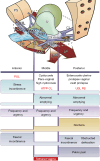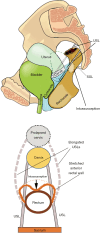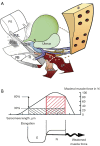A brief physiology and pathophysiology of the anorectum based on the Integral Theory paradigm
- PMID: 38721466
- PMCID: PMC11075962
- DOI: 10.21037/atm-23-1883
A brief physiology and pathophysiology of the anorectum based on the Integral Theory paradigm
Abstract
The remit of this review is confined to the experimental scientific works and surgeries based on the Integral Theory paradigm. The video abstract summarizes the anorectal function, how ligaments cause dysfunction and cure of fecal incontinence and obstructed defecation by ligament repair. Anorectal function is reflex and binary, with cortical and peripheral components. The same three oppositely acting reflex muscle forces which open and close the bladder, contract against the pubourethral (PUL) and uterosacral (USL) ligaments: (I) to close the anorectum for continence when the puborectalis muscle (PRM) contracts forwards; (II) to open the anorectum prior to evacuation when the PRM relaxes; (III) to stretch the rectum in opposite directions to support the anorectal stretch receptors "N" to prevent premature activation of the defecation reflex, (fecal urgency). Weak or loose PULs or USLs may cause dysfunction of closure, of evacuation, and inability to control the defecation reflex (fecal urgency). Repair of the PUL and USL can improve or cure these dysfunctions. The perineal body (PB) acts as an anatomical support for the distal vagina, anorectum and external anal sphincter (EAS). It serves as an anchoring point for the forward action of the pubococcygeus muscle (PCM), which tensions the anterior rectal wall during closure and defecation. Bladder and bowel dysfunction have a similar pathogenesis, ligament laxity, mainly pubourethral and uterosacral, with added PB damage for anorectal dysfunction. PB damage can cause obstructive defecation and descending perineal syndrome (DPS). Repair of damaged PUL and USL can restore the closure and evacuation functions of both bladder an anorectum. DPS can be cured by repair of the PB's suspensory ligaments, deep transversus perinei.
Keywords: Rectum; anus; binary control; fecal incontinence (FI); obstructed defecation.
2024 Annals of Translational Medicine. All rights reserved.
Conflict of interest statement
Conflicts of Interest: All authors have completed the ICMJE uniform disclosure form (available at https://atm.amegroups.com/article/view/10.21037/atm-23-1883/coif). The series “Integral Theory Paradigm” was commissioned by the International Society for Pelviperineology without any funding or sponsorship. The authors have no other conflicts of interest to declare.
Figures















References
-
- Petros P, Swash M. The Musculo-Elastic Theory of anorectal function and dysfunction. Pelviperineology 2008;27:89-93.
Publication types
LinkOut - more resources
Full Text Sources
